Another module built and installed. This module is my representation of Brittain Yard’s east end. Considerable artistic license has been applied. Specifically, moving Mack Concrete and its associated spur much further west so I could model the industry in the corner of the room thus making good use of the triangular space. Conceptually it is still right, its position relative to the yard tracks is slightly different. I also have the very short spur coming off the yard throat modeled. You can barely see remnants of it in this 2015 Google maps image.
This module is my representation of Brittain Yard’s east end. Considerable artistic license has been applied. Specifically, moving Mack Concrete and its associated spur much further west so I could model the industry in the corner of the room thus making good use of the triangular space. Conceptually it is still right, its position relative to the yard tracks is slightly different. I also have the very short spur coming off the yard throat modeled. You can barely see remnants of it in this 2015 Google maps image.
The front edge of my benchwork would be a horizontal line between the yard and the interstate highway in the above image.
Speaking of corners, I installed the foam land form filler piece in the corner. It sits on a couple wood blocks tacked to the wall in the rear and on the back edge of the benchwork in the front. It can easily be lifted out for modeling at the bench. This will eventually be the home of Mack Concrete.
Building this module was plagued with mishaps involving switches. Both my fault, one by accident the other by sheer stupidity.
Dang It #1
I was happily soldering point rail feeders into switches in assembly line fashion when an industrial accident occurred. Do you know what happens when the little piece of 2×4 you are using as a hand rest slips away just as the soldering iron tip touches the wire inside the point rail rivet of a Walthers 3 way turnout? I found out. You melt the little rivet right through the throw bar in the blink of an eye. Why couldn’t it have happened on a plain turnout? Nooooo, it had to happen on the $50 unit that is soldered in every which way from Sunday.
So I set about making a new throwbar for the turnout I damaged. Cut, sand, drill, fit, gauge, solder, easy enough. Except it doesn’t work well. The point rails are so short on a 3 way turnout and so much of them is ground thin that there just isn’t sufficient length or rigidity in the rail to facilitate flexing. They don’t flex, they bend. They moved but they didn’t like it and it was immanently clear this was not a good solution. Plus, the side-to-side tension at the hinge joiner screamed eventual failure coming. It became apparent the original swiveling rivet attachment method is there for a reason.
OK, OK. Tear it out and build some  sort of swiveling point rail connections into the throw bar. Can’t replicate the little rivet deal without some unique tool to flare the little teeny tinney rivets I don’t have anyway. Cut, sand, fit, solder, solder, and solder some more. Finally come up with something using 14 ga copper wire and little circles cut from copper sheet. Couple hours later I have working point rails again but it ain’t pretty and I don’t like the movement of the points. Specifically them not seating well each time. It works but has source of random derailments written all over it.
sort of swiveling point rail connections into the throw bar. Can’t replicate the little rivet deal without some unique tool to flare the little teeny tinney rivets I don’t have anyway. Cut, sand, fit, solder, solder, and solder some more. Finally come up with something using 14 ga copper wire and little circles cut from copper sheet. Couple hours later I have working point rails again but it ain’t pretty and I don’t like the movement of the points. Specifically them not seating well each time. It works but has source of random derailments written all over it.
Screw it! Pull the whole 3 way out of the track work. I have one more 3 way in inventory for a different location on down the line. I’ll use it now and order another when I reach that point. Open the box which I had purchased three years earlier…. It appears to be new but is obviously a return some ham-fisted cobbler had unsoldered from his track. Cut in half rail joiners still in place and soldered with the worst joints I have ever seen. Blobs of cold joint solder on the gauge side of the rails! The spike heads broken on virtually every tie within several inches of the joiners and the whole unit has a bow worse than the swayback of our old horse Mosey. Two 3 ways in the trash can and three hours of wasted time. I turned the lights out and called it a day.
I bought another turnout and installation went without a hitch. Accident #1 resolved. Little did I know Murphy had another waiting for me.
Dang It #2
I have the module finished, tested, and painted. Minutes away from being installed back on the layout. Then I notice one of the switches no longer moves as smoothly as before. Upon inspection I see the point rails are scraping off the thin layer of paint on the tie immediately ahead of the point ends. I have seen this before. My usual fix is to slightly scrape the tie top with a razor blade. I do that on this one. Still not smooth. Mind you I have .047″ rods on the Tortoises so there is ample pressure to move the points.
I place my big clumsy fingers on the point rails, apply a little downward pressure, and sweep them back and forth figuring the base of the rails will scrape away whatever is causing the bind. Bad mistake. On a swipe I break the join from the itsy bitsy clip on the throw bar to the point rail. Crap. Track is painted, point wires are soldered in (about .100″ away on the connector clip), and I need to solder on the gage side of the rail. This isn’t going to be fun.
I carefully rotary wire brushed best I could, applied some flux, placed the rail, and grabbed my little 15W iron. Knowing the first touch has to a good one because the wheel flanges won’t cut me any slack if I place too much solder or the solder is where it isn’t supposed to be and I can’t dwell but just a split second or I’ll drop the point rail feed wire soldered in the rivet, I went in for the kill.
Hallelujah! Nailed it. One of the prettiest solder joints I have ever made. Cars roll over it interference free. And the switch now operates smoothly. Murphy may have tossed another one my way but this time he was shown who is boss. Who am I kidding? Murphy is innocent. It was my stupidity that caused the problem and fortunately my good luck to make a good fix.
Learning from Mistakes
There is positive outcome to the misadventures building this module. Verify the stability of one’s hand rest before soldering. Check. Don’t use fragile track components to scrape away paint. Check. The real gem from the experience is an awareness of the effect Tortoise rod placement plays in switch operation. So far I had been focused primarily on the side-to-side throw. Taking great pains to make sure it was centered. Admittedly, I had not paid a great deal of attention to the longitudinal position in relation to the throw bar. My process was eyeball lineup with no real testing. I know better now. Slight rod misalignment and the addition of a thin paint layer was the root reason for the switch bind. From here on out Tortoises, and specifically their rods, will be positioned with much greater accuracy. I am thankful I have been lucky as I have been so far.
Enough of the module #4 drama. It is done and working well. Here are a bunch of build pics for you.
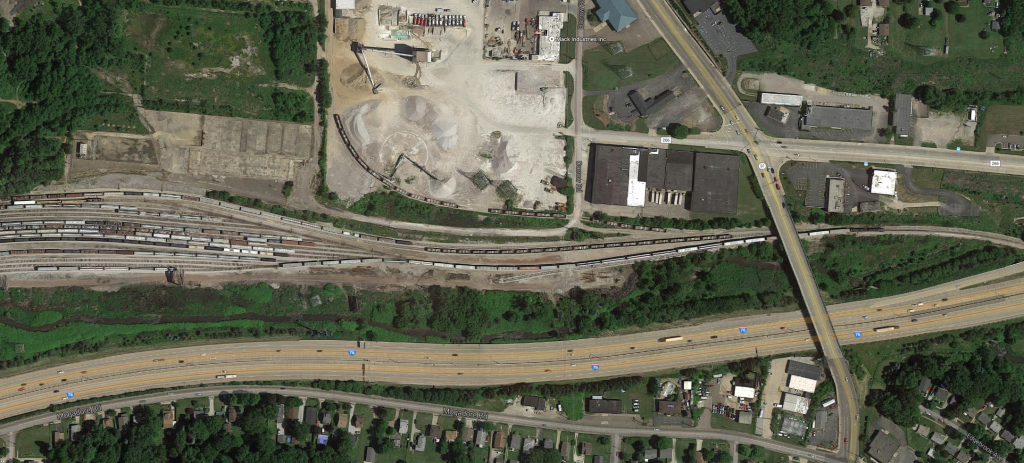
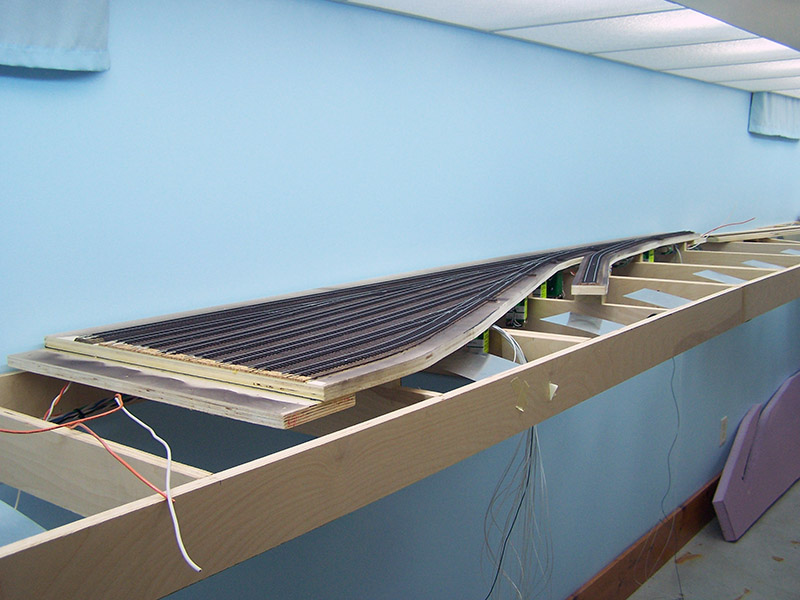

















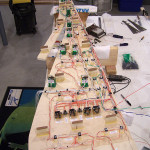



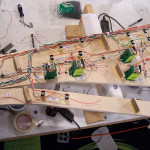





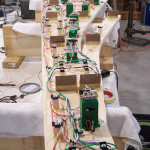





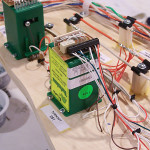
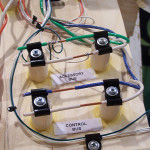




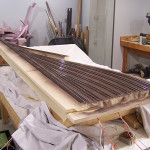






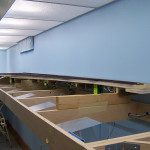

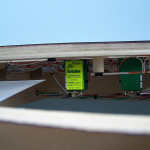







There was a 2-volume set of books published in the early 1990’s by a guy named Jeffery Sunderland, titled “The Rail Network of Summit, Medina, and Portage Counties”. There are hundreds of pages of hand-drawn diagrams of pretty much everywhere in those 3 counties, with Summit County being the most detailed. He has diagrams from the 1950’s up through the early 1990’s. Every foot of rail line in Akron is there and everything you are modeling is in there. Have you seen the books? I am certain they are out of print today. I have copies from Bierce Library at Akron U that I checked out 20 years ago and never returned, LOL.
I was made aware of The Jeffery Sunderland book(s) in a post last year on the AC&Y Historical Society forum.
http://www.acyhs.org/forum/viewtopic.php?f=5&t=791
Would have been very interesting to have had them back when I was in the design phase.
Your overdue book fine must be huge by now! 🙂
The books are great for any modeling based on the Akron area because what you see today is just a shell of what used to be there. It’s almost impossible to comprehend just how much rail there was around town in decades past.
I live about 300 yards due north of the turntable in Brittain Yard. Some mornings I can smell the diesel fumes from the idling locomotives in the yard.
Anyway, I enjoy your blog and someday when I have the room to build I will be using it as a reference guide. Keep up the good work!
I can not begin to say how much I enjoy your website. I still believe it sets the standard for construction and attention to detail.
I do have a question. I noticed that the track layout for Module 4 is not the same as your original track plan. Can you shed some light on why you changed it? I did go back through your post and did see in your Laying Track post an adjusted track plan, however I could not find any discussion on the change.
Just curious what drove the change.
Art
Art, thank you for the kind words.
There were actually four minor changes to the track plan in this area.
1. Originally the yard had separate arrival and departure tracks to mimic the original Brittain Yard. I reduced it to a single arrival/departure track because the track was too close to the wall. It left no room to scenic blend behind the track. During design I expected to use a photo backdrop to solve the situation. Upon further reflection I found that I liked the backdrop only idea less and less.
2. With only a single AD track the Mack Concrete spur switch was moved closer to the facility. Same reason as above. It was too close to the wall.
3. Removal of the second AD track allowed me to slightly reshape the east end yard throat to reduce the severity of S curves coming into the yard.
4. Spur added just east of the yard throat. This spur was originally at Brittain Yard although I do not know what it was used for. I added it to give me one more industry to switch. That industry has not yet been defined.
I will soon post an updated image on the track plan tab.
Thanks,
Art